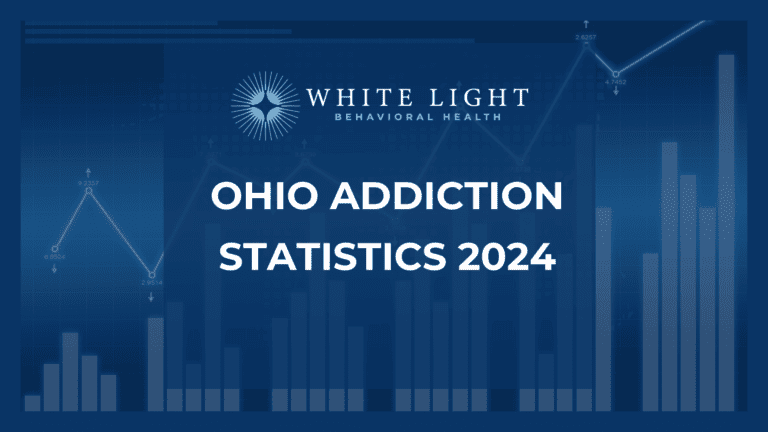White Light Behavioral Health serves as a sanctuary for recovery, meeting each individual’s unique needs with personalized recovery planning and comfortable, discreet treatment. Our alcohol detox and treatment programs are tailored to meet the specific needs of our clients, ensuring that every aspect of their care is personalized. We emphasize a holistic approach to recovery, incorporating medical treatment, mental health support, and wellness programs to address all facets of Alcohol Use disorder (AUD). Our facility in Ohio is equipped with the latest in addiction treatment technology, including Transcranial Magnetic Stimulation (TMS) therapy for those battling co-occurring depression. By focusing on dual diagnosis treatment, we ensure that underlying mental health conditions are addressed alongside addiction, providing a foundation for long-term recovery.
In Ohio, the battle against alcohol addiction is underscored by concerning statistics from the CDC, highlighting that excessive drinking results in 3,288 deaths and 91,851 years of potential life lost each year in Ohio and 20.1% of adults and 23.7% of high school students reported binge drinking in 2011.
Excessive alcohol use in Ohio encompasses patterns like binge drinking or heavy weekly drinking, leading to the most common fatalities including poisonings, heart disease, liver complications, suicides, vehicular accidents, and homicides.
Why Choose White Light For Alcohol Detox And Rehab?
- Highly Skilled Medical Team: At the core of our exceptional care is our medical team, comprising board-certified psychiatrists, nurse practitioners, addiction specialists, and now featuring 24-hour nursing and behavioral health technician support. This round-the-clock assistance ensures that our clients receive the utmost care at every step of their recovery journey.
- Relevant Certifications and Accreditations: White Light is not only accredited by the Joint Commission but also recognized by CARF (Commission on Accreditation of Rehabilitation Facilities). These accreditations affirm our commitment to meeting rigorous standards for healthcare quality and safety, guaranteeing our clients receive the highest standard of care.
- Continuous Care Availability: We offer a seamless continuum of care, from detox through outpatient services, allowing our clients to progress through the stages of treatment with consistent support. This continuity is crucial for long-term recovery and ensures that our clients always have the resources they need.
- Treatment Intensity Options: Recognizing that recovery is a deeply personal journey, we offer a variety of treatment options to cater to each client’s individual needs. Whether you’re looking for intensive care or a more flexible treatment plan, we have options that can be tailored to suit your path to recovery.
- Nurturing Environment: Our Ohio facility is thoughtfully designed to promote healing and growth. With comfortable accommodations, outdoor recreational activities, and communal spaces for social interaction, White Light provides a nurturing environment conducive to recovery and wellness.
Who is Alcohol Detox And Treatment for?
Alcohol detox is specifically tailored for individuals who are struggling with alcohol abuse and find themselves incapable of stopping use without encountering physical withdrawal symptoms.
This necessity for detoxification particularly applies to:
- Heavy Drinkers: Individuals who consume alcohol in large amounts regularly.
- Severe Alcoholics: Those with a profound dependency on alcohol, where abstinence leads to severe withdrawal symptoms.
- Binge Drinkers: Individuals who consume excessive amounts of alcohol in short periods and experience withdrawal symptoms afterward.
Furthermore, patients might also present with co-occurring conditions such as:
- Polysubstance Use Disorder: An addiction to multiple types of drugs alongside alcohol.
- Dual Diagnosis Mental Health Conditions: The presence of mental health issues alongside substance abuse disorders.
White Light is dedicated to delivering the highest standard of care, accommodating a wide range of individuals, including professionals in search of confidential treatment options, those battling with mental health challenges, and adults over the age of 18 seeking assistance. Our approach is inclusive, serving individuals from all walks of life with a commitment to excellence in recovery and rehabilitation.
What Is Detox And Rehab Like For Alcohol Use Disorder?

At White Light Behavioral Health, we provide unparalleled care through our holistic alcohol detox and rehab program, meticulously designed to cater to your distinct needs. Our approach encompasses comprehensive psychological evaluations and ongoing assessments for any co-occurring disorders, ensuring you or your loved one receive the precise, individualized care essential for the recovery journey. We value transparent communication and excellence in service, aiming to introduce you to effective coping strategies that eliminate the need for self-medication. Our compassionate and proficient care team employs mental health evaluations and personalized counseling to develop a treatment plan that specifically targets your needs and concerns, substantially improving your chances of achieving lasting recovery. The cornerstone features of our alcohol detox and rehab program include:
- A team of seasoned, licensed, and accredited clinical experts
- An onsite, fully equipped detox facility, reopening soon
- Acceptance of various insurance plans to facilitate access
- An average stay of 28 days, with possibilities for longer stays based on clinical advisement
- In-depth psychological evaluations and treatment options
- Designated areas for smoking
- Controlled, supervised work access contingent upon appropriateness
- Permission for family and children contact in the initial 28 days

Understanding Alcohol Withdrawal
Withdrawal is experienced when a heavy user of alcohol suddenly stops consuming it completely. Symptoms can appear as soon as a few hours after your last drink or up to five days later.
- Withdrawal is usually a consequence of heavy, prolonged drinking. Its symptoms include:
- Hand and/or head tremors
- Nausea and vomiting
- Agitation and irritability
- Anxiety
- Depression
- Sudden bouts of sweating
The Importance of Getting Help During Alcohol Withdrawal
Suddenly stopping any substance use can lead to emotional anguish and physical discomfort. However, alcohol withdrawal is one of the few cases where the process is potentially fatal without medical supervision.

Withdrawal can occur on a spectrum that depends on a range of factors that influence the severity. On the severe end of the spectrum is a condition called Alcohol Withdrawal Syndrome (AWS).
AWS is a more severe form of alcohol withdrawal that’s likely to affect heavy, long-term drinkers nearly three times more often than people with mild to moderate AUD.
In addition to typical, milder alcohol withdrawal symptoms, signs of AWS include:
- Itching, burning sensations, or numbness
- Auditory disturbances, such as sensitivity to sounds
- Visual and auditory hallucinations
- Feelings of fullness in the head
- Disorientation
- Hyperactivity
- Insomnia
- Seizures
- Delirium tremens (DTs)
Risk Factors for Alcohol Withdrawal
Not everyone who is a heavy or frequent drinker will develop AWS if they try to quit. For example, DTs affect only about 5% of those who are going through withdrawal.
However, some factors put you at higher risk for AWS. These include:
- Drinking from an early age
- Poor health/mental health or a history of trauma
- Family history of AUD
The Full Continuum Of Care For Recovery From Alcohol Use Disorder
White Light Behavioral Health offers a comprehensive suite of services designed to support individuals through every stage of recovery, including:
- Medical Detoxification: Our medical team provides around-the-clock care to manage withdrawal symptoms safely, using medication-assisted treatment when appropriate to ease discomfort and cravings.
- Residential Rehabilitation: For those requiring a structured environment, our residential program offers intensive care and support within our Ohio facility, focusing on building healthy coping mechanisms and life skills.
- Dual Diagnosis Treatment: Recognizing the complex relationship between addiction and mental health, our dual diagnosis program offers specialized treatment for co-occurring disorders, ensuring a holistic approach to recovery.
- Intensive Outpatient Program: Understanding the need for flexible treatment options, our intensive outpatient program allows individuals to receive thorough treatment and support while maintaining their daily responsibilities. This program focuses on offering continued care and support, facilitating the transition into everyday life with structured therapy sessions and recovery activities.
Our Detox Programs At White Light In Ohio
At White Light Behavioral Health, we are dedicated to providing specialized detox programs that cater to the unique needs of each individual. Our comprehensive approach ensures a supportive and effective pathway to recovery for those struggling with substance dependence. Below is a list of our detox programs:
- Alcohol Detox
- Adderall Detox
- Benzodiazepine Detox
- Cocaine Detox
- Fentanyl Detox
- Klonopin Detox
- Heroin Detox
- Meth Detox
- Opioid Detox
- Suboxone Detox
- Xanax Detox

How Does Alcohol Treatment Start?
Setting out on the path to recovery at White Light begins with a simple, compassionate admission process. From the moment you reach out, our dedicated team provides personalized assistance to navigate the complexities of starting treatment, including insurance verification and an overview of what to expect. Our program is distinctive for its comprehensive approach, offering everything from initial detox to outpatient support, all tailored to the individual’s specific needs and circumstances. Specializing in dual diagnosis, White Light ensures that clients receive holistic treatment that addresses both addiction and underlying mental health issues, facilitated by our team of experienced professionals. This integrated treatment model is pivotal for fostering long-term sobriety and mental well-being.
Directions To White Light Behavioral Health In Columbus Ohio
Finding White Light Behavioral Health is straightforward, thanks to our convenient location in Ohio. For those considering visiting or beginning their journey with us, we’ve made it easy to locate our facility:
Take the First Step with White Light Behavioral Health
Recovery from alcohol addiction starts with a decision to seek help. At White Light Behavioral Health, we’re here to guide you through every step of that journey, offering a comprehensive treatment program that respects your individuality and addresses your specific needs. If you or a loved one is struggling with alcohol addiction, we invite you to learn more about our detox and treatment options in Ohio. Let us be part of your journey to a healthier, sober life.
Frequently Asked Questions About Alcohol Detox In Ohio (FAQs)
What insurance plans do you accept?
White Light Behavioral Health is dedicated to making our treatment programs accessible to as many individuals as possible. We accept a wide range of insurance plans, including but not limited to Cigna, UMR, Anthem, and Humana. Our team works diligently to verify insurance coverage and discuss potential out-of-pocket costs to ensure transparency and affordability for our clients.
What types of therapy are offered during treatment for alcoholics?
Our treatment programs incorporate a variety of evidence-based and holistic therapy approaches to address the complexities of alcohol addiction. Clients have access to Cognitive Behavioral Therapy (CBT), Dialectical Behavior Therapy (DBT), Eye Movement Desensitization and Reprocessing (EMDR), as well as grief and loss counseling, and trauma therapy. These modalities are tailored to meet the individual needs of our clients, supporting them in overcoming addiction and achieving long-term sobriety.
How do you handle dual diagnosis and mental health treatment?
At White Light Behavioral Health, we recognize the significant impact of co-occurring mental health disorders on addiction recovery. Our dual diagnosis program is designed to treat these intertwined issues concurrently. By employing a team of psychiatric professionals and utilizing a comprehensive treatment approach, we ensure that both the addiction and any underlying mental health conditions are addressed together, enhancing the chances of successful recovery and minimizing the risk of relapse.
Can I Bring My Cell Phone To Treatment?
Yes, clients are allowed to bring their cell phones to treatment. We understand the importance of staying connected with your support network during this challenging time. However, to ensure a focused and supportive healing environment for everyone, cell phone use will be permitted at designated times throughout the day.
Can I Smoke While In Detox?
Yes, smoking is permitted during detox at White Light Behavioral Health, but only at designated times and in specific areas designated for smoking. We recognize the need for clients to have access to their coping mechanisms during the detox process, and we strive to accommodate this need while maintaining a safe and comfortable environment for all clients.
What If I'm Drinking And Doing Other Drugs Simultaneously Like Cocaine?
White Light Behavioral Health is proud to offer programs for polysubstance use disorder. If you are drinking alcohol and also need treatment for cocaine addiction, we will address both substances during detox and rehabilitation.



